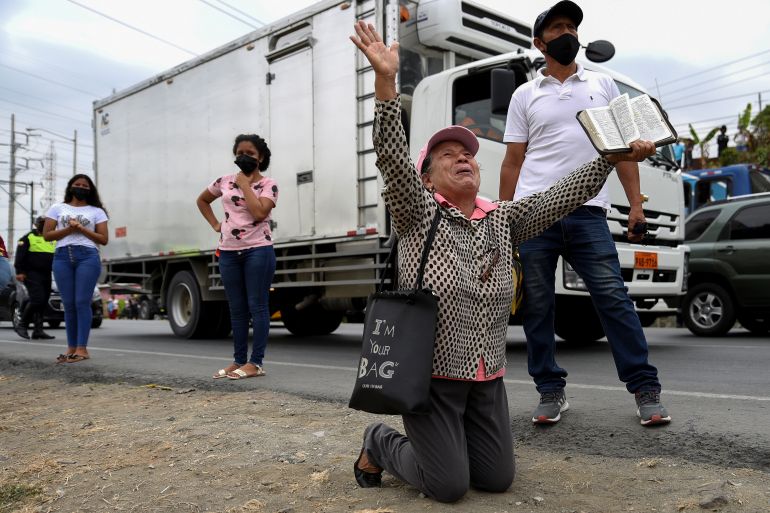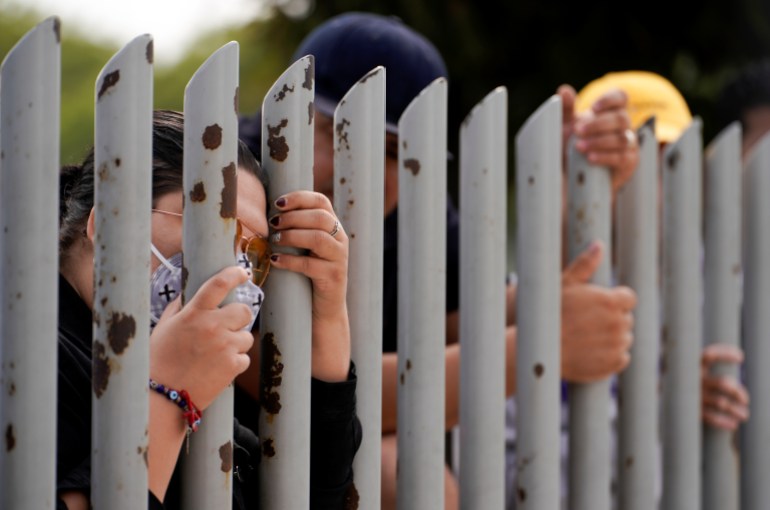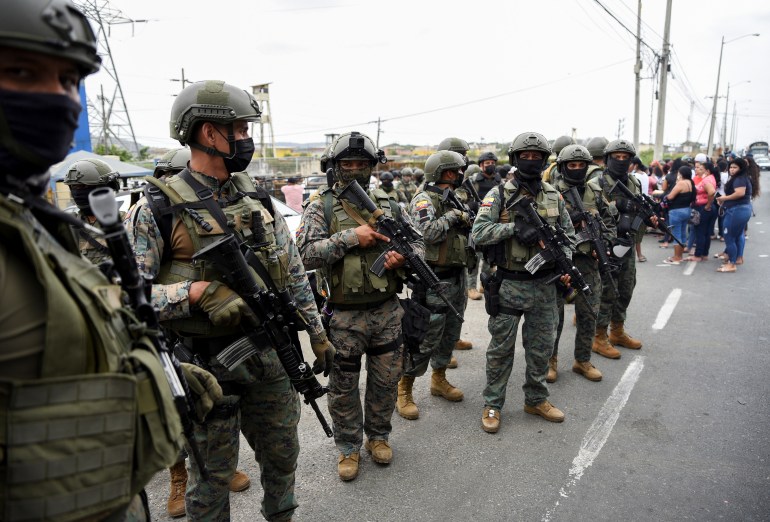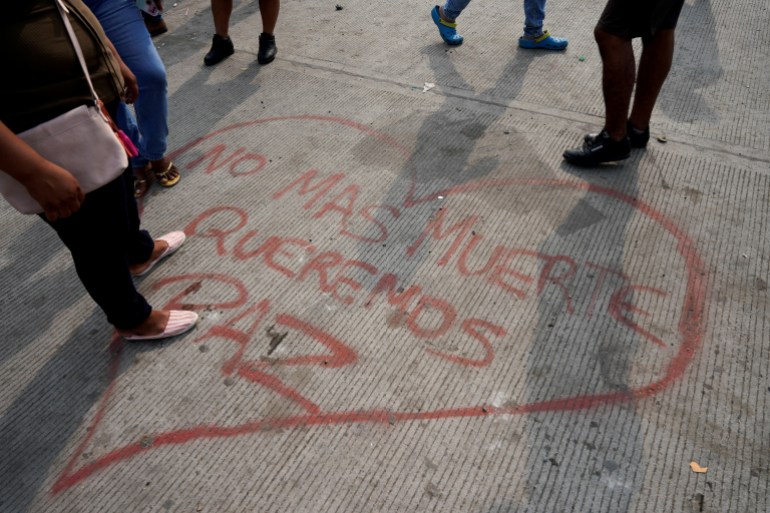‘We are all suffering’: What’s going on inside Ecuador’s prisons?
Hundreds have been killed in gang-linked riots this year, as experts say systemic problems plague country’s prisons.

Quito, Ecuador – More than 300 people have been killed inside Ecuador’s prisons so far this year, as a series of violent riots between rival gangs left officials scrambling to find ways to end the bloodshed.
The latest riot took place last week behind the cement walls of Penitenciaria del Litoral, a facility in the coastal city of Guayaquil, a little more than a month after 119 people – all inmates – were killed in the same facility in what was the country’s deadliest prison massacre on record.
Keep reading
list of 4 itemsEcuador to pardon up to 2,000 inmates after deadly prison riot
Ecuador president declares state of emergency over drug violence
Dozens of inmates killed in latest Ecuador prison clashes
Family members have been increasingly anxious since the September killings at Litoral, which prompted the Ecuadorian government to declare a state of emergency and send hundreds of police officers to reinforce the prison.
They say their loved ones face a constant threat of violence inside the facility, while explosions and gunfire also can be regularly seen and heard from outside the compound. Last week, videos surfaced showing some inmates torturing others. The footage was sent to inmates’ families to extort them for money in exchange for their loved one’s safety, several local media outlets reported.
Billy Navarrete, director of the Committee for the Defence of Human Rights in Guayaquil, said the families of Litoral inmates are “completely terrified” – both of what is occurring inside the prison, but also of the criminal groups that control the facility.
These groups have networks outside the prison, which the families have said also puts them at direct risk, Navarrete told Al Jazeera.
“The situation is difficult,” said one mother whose son is currently being held behind bars in Guayaquil. She spoke to Al Jazeera on condition of anonymity for both her and her son due to fears of retribution from armed groups.
“We are all suffering for the same reason,” she said in a phone interview. “Like all the other mothers in Guayaquil say, [authorities] don’t give information, we don’t know anything, we don’t have access to anything.”
Systemic problems
Security experts in Ecuador have identified 11 armed groups that control the country’s prisons, including Ecuador’s largest, Los Choneros – and also Lagartos, Tiguerones, Lobos, Chone Killers, Fatales, Netas, Aguilas, Fantasmas and Cubanos.
These groups battle for power inside and outside of prisons, seeking control of cocaine routes, as Ecuador has long been a transit hub for drugs leaving to the United States and Europe.
The violence in Ecuadorian prisons increased in 2019 when the leader of Los Cubanos, known by the alias El Cubano, was killed in another Guayaquil prison. Then, in December 2020, the leader of Los Choneros, alias Rasquina, was killed publicly in the coastal city of Manta after being released from prison. Both incidents sparked a series of turf wars over leadership and territory, according to the country’s security experts.
But Navarrete, who has been monitoring Ecuador’s prison system for more than 30 years, said the issue should not be “reduced to gang fighting” alone, as the current surge in violence has been in the making for years.

The real problem is that Ecuador’s penitentiary system has been abandoned by current and past governments, he said. This includes a lack of rehabilitation programmes – such as education, sport, or job training, which the state never properly developed; a 30 percent overcrowding rate nationally, and a lack of trained administrative staff and guards, some of whom have been accused of ignoring or even facilitating the smuggling of weapons into the facilities.
Navarrete, who has been aiding families of the victims of the riots in Litoral, said the only way Ecuadorian authorities were able to identify the bodies of those killed was from the information that family members gave them, including tattoos and special body markings, and what part of the prison they were held in.
“Prison directors don’t even know who inhabits each prison wing. That’s evidence of lack of control,” said Navarrete, adding, “This is especially serious because one of the essential conditions in their rehabilitation process is that they be categorised by crime.”
Government response
Ecuador’s Human Rights Secretariat, a government agency, recently released data on the victims of the September riots at Litoral, which was described by security experts as a battle between Los Tiguerones, working together with Los Lobos, and Los Choneros to gain control over one of the prison wings.
It found that 75 percent of those killed were being held prior to sentencing – meaning they had not been found guilty of any crimes – and that 61 percent were under the age of 30.
Following the massacre, President Guillermo Lasso declared a state of emergency in Ecuador’s prison system that is still in place today, which allowed more police and military officers to be deployed outside of the prison compounds to respond to violence more rapidly and stop the flow of weapons going inside.
This is the fourth state of emergency applied to Ecuador’s prisons since 2019.

In a televised address on November 15, Lasso also announced plans to bolster the military presence in the country’s prisons, which will include them participating in security controls both inside and outside the prison compounds, and to get help from allies such as the US and Colombia to crack down on drug trafficking in the country.
In a tweet that same night, Lasso emphasised that the government’s plan was to “attack the root of the problem: the heads of the mafias”.
He also is expected to present a new bill to restructure and coordinate all public entities involved in the national rehabilitation programme for people behind bars, but has not gone into further detail as to what this would entail.
In 2020, former President Lenin Moreno decreased the prison budget during the coronavirus pandemic by 15 percent, bringing it down to $91m, which is divided between paying for guards’ salaries, private food companies, and rehabilitation programmes.
Militarisation not the answer: Expert
But Jorge Nunez, an anthropologist who has studied Ecuador’s prison population for nearly two decades and co-director of the Kaleidos – Center for Interdisciplinary Ethnography at the University of Cuenca, said militarising prison compounds will only worsen the situation.
“The reason the violence has not gone down is because they have not stopped doing what has caused the violence,” he told Al Jazeera in a phone interview from Princeton University in the US, where he is currently a visiting researcher at the Institute for Advanced Study.
The Ecuadorian authorities have never had control of Ecuador’s prisons, said Nunez, but the situation worsened after a series of decisions in 2014 and 2015 that included moving prisoners to penitentiaries farther away from their families – whose presence often lessen the risk of prison violence, experts have said – and restricting visiting hours.
A new criminal code expanded the list of punishable crimes in Ecuador, which in turn led to an increase in the number of people being incarcerated, Nunez also explained.
Further, authorities created what is known as the penitentiary intelligence unit, a special police intelligence unit, to investigate drug trafficking in urban centres using information from people behind bars. Nunez said this created a system of police exchanging favours with people behind bars for information, unwittingly empowering some groups and creating a culture of snitching.
“This broke the prisoner code that operated before,” said Nunez, adding that the government’s focus on cracking down on armed groups “allows it to not see what its role has been in the generation of this violence”.
What next?
Neither the national prison management system (SNAI) or the Human Rights Secretariat – the two bodies responsible for responding to the human rights and security situation in Ecuador’s prisons – responded to several requests for comment from Al Jazeera in time for publication.
Both the head of the armed forces and the director of SNAI, who had only occupied the position for 47 days, resigned on Sunday, just two days after the latest riots at in Litoral. The previous director of SNAI, Fausto Cobo, took back up the position and told local media on Tuesday that officials still do not have control over the wings of the compound.
Meanwhile, this month, the Sovereignty, Integration and Integral Security Commission, a special committee of lawmakers in Ecuador’s National Assembly, presented an in-depth report on the country’s prisons that includes dozens of recommendations for improvements.
Ramiro Narvaez, president of the commission and a lawmaker with the Izquierda Democratica (Democratic Left) party, said the entire network suffers from “totally inadequate conditions”, including failing infrastructure such as non-functioning security scanners, cameras and mobile phone signal inhibitors.

Inmates do not have access to adequate healthcare within the facilities, Narvaez said, while entire prisons are under the control of armed groups and “warlords”, many of whom have the keys to the prisoner’s own cells. “If the prisoners don’t attack again, it’s because they don’t want to. They can do it whenever they want,” Narvaez told Al Jazeera.
“Those who run the prisons are the prisoners,” he said, adding that the group of lawmakers that collected information as part of the commission’s probe was not able to enter the wings of Litoral for security reasons.
The report offers 70 recommendations to improve the situation, but Narvaez highlighted the immediate need to restructure and strengthen the prison rehabilitation system and dismantle the armed groups who maintain control of the facilities.
“Entering with violence is not the solution. You can’t have a focus on militarisation and repression, you have to have a focus on rehabilitation, otherwise it won’t work,” said Narvaez.